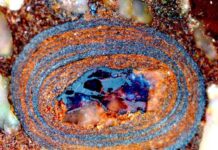Curtin University-led research has found new evidence to suggest that the Earth’s first continents were not formed by subduction in a modern-like plate tectonics environment as previously thought, and instead may have been created by an entirely different process.
Published in the journal Geology, the research team measured the iron and zinc isotopes in rock sourced from central Siberia and South Africa and determined that the composition of these rocks may have formed in a non-subduction environment.
Lead author Dr Luc-Serge Doucet, from the Earth Dynamics Research Group in Curtin’s School of Earth and Planetary Sciences, said the first continents were formed early in Earth’s history more than three billion years ago, but how they were formed is still open to debate.
“Previous research has suggested that the first supercontinents formed through subduction and plate tectonics, which is when the Earth’s plates move under one another shaping the mountains and oceans,” Dr Doucet said.
“Our research found that that the chemical makeup of the rock fragments was not consistent with what we would usually see when subduction occurs. If the continents were formed through subduction and plate tectonics we would expect the ratio of iron and zinc isotopes to be either very high or very low, but our analyses instead found the ratio of isotopes was similar to that found in non-subduction rocks.”
Dr Doucet said the team used a relatively new technique known as the non-traditional stable isotope method, which has been used to pinpoint the processes that formed continental and mantle rocks.
“Our research provides a new, but unknown theory as to how the Earth’s continents formed more than three billion years ago. Further research will be needed to determine what the unknown explanation is,” Dr Doucet said.
###
The research was co-authored by researchers from Curtin’s Earth Dynamics Research Group,
Université Libre de Bruxelles in Belgium, Institute for Geochemistry and Petrology in Switzerland, and Université de Montpellier in France.
The full paper is titled, ‘Archean lithospheric differentiation: Insights from Fe and Zn isotopes’, and can be found online here.
TDnews














